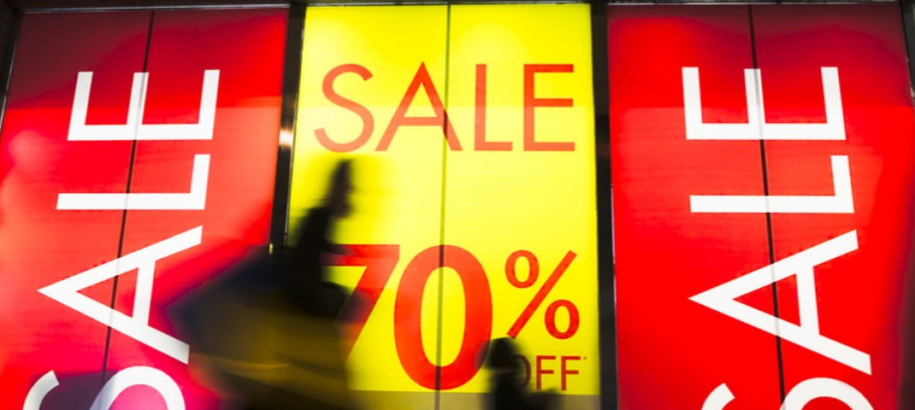
Ben Hoffman
Last Yard
Since making this blog post, SignIQ has changed its name to Last Yard.
Humans seem to be wired to love getting a bargain. They hunt them out and make purchases based on the bargain, even when it is not always a rational decision. Often a bargain gives shoppers the “reason” or “permission” to make a purchase that they can then rationalise later.
Value is a brand, bargains are an experience
Value can create loyalty with customers and can be a very effective branding and pricing strategy. However, value does not provide the discount experience that can increase basket sizes with impulse purchases.
It is important to understand that discount promotions can lead stores into margin-reducing cycles. Even the highest value promotions can fail to secure a sale if the retailer hasn’t engineered the promotion around the basic principles of consumer psychology.
Why do discounts work?
Most discounts work on the principle of urgency, as the discounts are only available for a specific period of time. If people don’t buy the product now, at the discounted price, they’re likely to miss out on saving some money. That anticipation of missing out is exactly why discounts work.
Urgency is a critical element in moving customers past the purchase threshold and can be aided with your in-store ticketing strategy and design. For example, including “One day only” or “Last chance!” messaging helps remove any hesitations that may be holding customers back.
Importantly, discounts only work if the customer knows about them and understands the value and urgency of the discount. If a discount is not advertised or the value is not recognizable to the average shopper at a glance, then the discount is missing the opportunity to result in impulse purchases.
Perceptions of value
It is also important to understand that the perceived value of discounts are relative. A $10 discount on a $100 product will be regarded as much less than a $10 off a $20 product.
Shoppers will go out of their way to visit a shop for that $10 discount on the $20 product but would not put in the same effort to go out of their way to save $10 on the $100 product. The dollar saving is the same, but the perceived value is not.
Understanding the offer
People are pretty bad at fractions and calculating the savings or value of a discount and most of all comparing different types of discounts. Ticketing has to simplify the message and clearly advertise the value of the discount. It needs to be simple enough to allow our monkey brains to kick in and make a snap judgement.
Example. Which of the following discounts represents the biggest percentage discount?
$100 off a $499
$75 from a regular price of $100
Buy one for $80, get the second for 50% off
Answer: $75 from a regular price of $100
As you can see, it is not automatically obvious which discounts have the highest percentage of value. In fact, at times retailers can take advantage of this and pick the promotional type that appears to be the best value.
In its simplest form, ticketing can just announce that a product is on promotion. Often the shopper will just trust that there is a discount applied to that special and regardless of the value of the discount may be influenced to make the purchase. Especially if they already inclined to make the purchase.
Discount Types
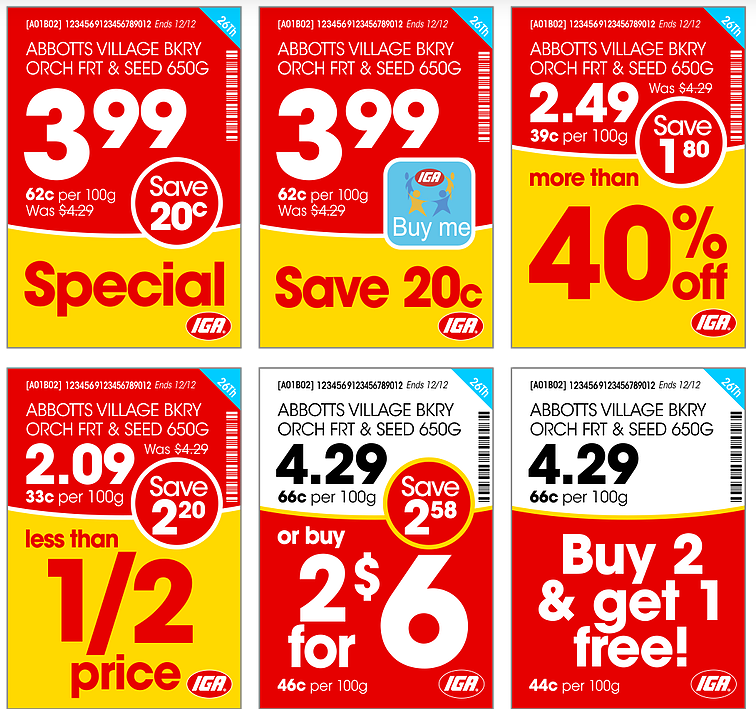
Before you begin experimenting with your discount tactics, you should know more about the most common discount types, summarized below:
Dollar or Percentage Off
This discount type is the most standard and widely used, simply offering a reduction on the original price, such as $25 off or 20% off. These discounts can be placed on specific products or groups of products. Deciding between whether to highlight the $ or % off depends on the perceived value.
Saving 25% of a stick of $1 gum is much more compelling that saving 25c.
Saving $25 of a pair of $100 jeans can be more compelling than saving 25% off as $25 is much more tangible saving.
Buy One Get One (BOGO)
BOGO discounts prompt customers to purchase additional items and can be very effective at increasing the number of items sold. Examples of BOGO include, “Buy 1, Get 1 Free” or “Buy One, Get 50% Off the Next Item”.
Quantity Discounts
Quantity discounts also encourage shoppers to increase the number of items purchased. Shoppers must reach a specific threshold to receive a discount. For example, “Purchase 2 items and get the 3rd free” or “Receive 20% off your $100 purchase”.
Multibuys
Multibuys are similar to Quantity discounts in that they encourage the customer to purchase multiple items but do not have the “Free” element. Example, “3 for $2”.
Rebates
A rebate is an amount that’s returned or refunded to customers after their initial purchase. This discount is often used for large-ticket items, the most common form is a mail-in rebate and is often offered by the manufacturer than the retailer. An example of this would be listing a price as, “$349.99 after rebate.”. It allows the retailer to advertise the lower rebated price.
Free Shipping
This is popular among online stores but can still be applicable to physical stores. Many stores offer free shipping for a certain order amount or on large ticket bulky items that the customer cannot easily walk out of the store with. The disadvantage of this offer is that the shopper often does not factor in the cost of shipping when making a purchasing decision. The shipping saving is often associated with the convenience factor of organising their own pickup and is therefore evaluated (justified) separate from the purchased goods.
Loyalty Discounts
If you have a Loyalty Program then a good strategy is to tie some of your promotions to your loyalty program. This can be a great way to both reward and show your gratitude to your existing customers but is also a great way to provide a constant reminder to your no loyalty customers of the value of becoming a member.
As with the power of “Urgency” (which is really just Fear of Missing Out) it creates that fear of missing out to drive customers to your loyalty program.
Rewards and loyalty discounts should be front and center on the shelf, this helps drive member signups.
Or, if you’re looking to encourage spending among existing members, why not run an exclusive promo just for your loyal customers? Turn it into an event. Your loyal patrons will love the exclusivity, and you could gain a lot of sales out of it.
This is a constant in-store reminder of the value of joining the loyalty program.
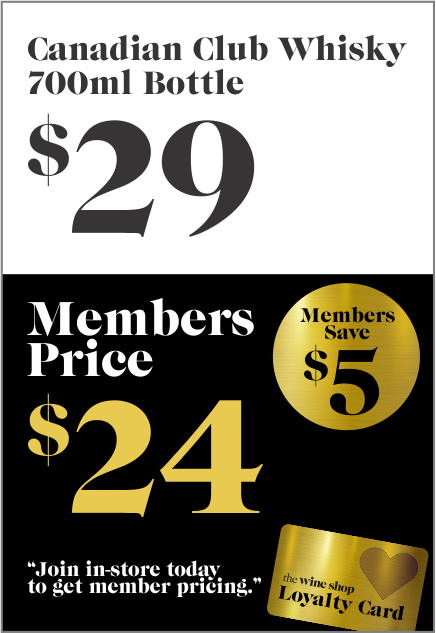
How do discounts work?
Wording
The wording has a lot of impact on how people perceive your discounts. For instance, “Get $ off” emphasizes achieving a gain, while “Save $” emphasizes avoiding a loss. You should test which kind of wording works best for your brand. This basically depends on your customers; are they more likely to achieve a gain or more likely to avoid a loss?
In general, it has been found that wording like “Get $ off RRP” will motivate people to buy more, even if the other products are not actually on sale.
Another example of the power of words is that you might actually consider dropping the dollar sign altogether. Karl Gilis of AGConsult explains this in his Dutch article: 6 Unexpected tips to sell more using pricing psychology. The dollar sign actually reminds people of the pain of paying for something. Reducing the size of the sign, of simply removing it really seems to push sales. Conversely, showing the $ sign on the saving amount reinforces gain of the discount.
Power & danger of the ‘9’
We all know the power of advertising a product at 9.99 looks cheaper than 10, even when we know the trick. Every shopper does, the thing is it still works as our monkey brains just keep getting fooled.
The flip side of this is that discounts should be designed so that when the % or $ saving is the primary promotional message then the ‘9’ starts to work against you. 40% off looks better than 39.99% and Save $10 looks better than Save $9.99. Such a simple consideration in your pricing strategy can have a considerable effect at the shelf. The addition of a cent to the saving can make a huge difference in the appearance of the discount.
Sometimes you have to view your pricing strategy from the perspective of the shelf ticket first.
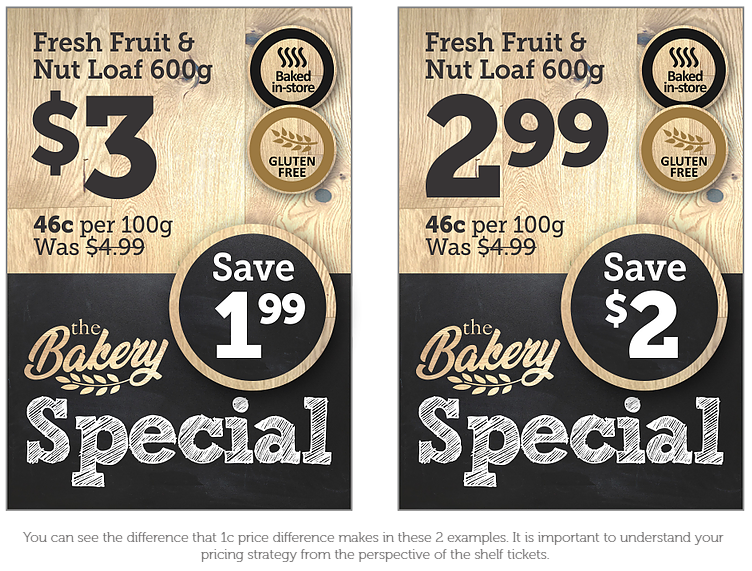
Duration of the discount
Most discounts work on the principle of urgency, as the discounts are only available for a specific period of time. If people don’t buy the product now, at the discounted price, they’re likely to miss out on saving some money. There is urgency involved. That anticipation of missing out is exactly why discounts work.
Every Day Low Price (EDLP) v Promotion, getting the mix right
The risk of running a promotion longer than a couple of weeks is that the longer it runs the greater the risk of negating the sense of urgency. Promotions that run for a month or in some cases up to 3 months lose a lot of their power and you end up giving the discount without the return of increased sales. If the shopper knows that a particular discount will still be available the next time they return to the store then there is not urgency to purchase the product now. There is probably a “law of diminishing returns” that could be applied to promotion duration.
At some point you will probably get more value in making the discount a longer term “Every Day Low Price” strategy that creates a sense of permanent value across the store. Shoppers staples that have a EDLP pricing strategy may not get the “urgency” sale but will potentially get the sales uplift from recurring visits when the shopper trust they are getting everyday value. Sure, you miss out on the experience of finding a bargain, but what you lose it made up for in trust.
Think about how long you’d want the discount to last and make sure it is clearly communicated. Remember, an “urgency” based discount only works of the shopper is aware it if only available for a short time and an EDLP based promotion only works when the customer knows they will always get this price. Clearly communicating the nature of the promotion is key.
Re-framing the value
How does a shopper compare the cost of a can of soft drink they purchase from a local deli or service station with a carton of 24 cans at a grocery store? An individual can of Coke may cost $3 and a carton of 24 cans may cost $13 on promotion. Using comparative unit pricing doesn’t help as a carton and single cans are rarely located together on the shelf.
Break the value into units that can be easily understood
The reality is that the cost per can by the carton is 55c compared to the single can cost of $3. That is a massive difference. Signage that frames the promotion as a cost per can is much more relatable for the shopper as it provides a frame of reference. This is particularly effective for the category of products that are often sold in bulk in a store but also sold as single items in other places.
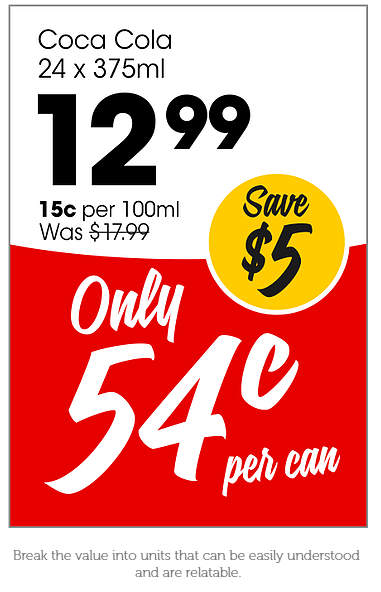
Reduce pain points and decision frequency with bundling
Shoppers are more likely to purchase additional products or larger quantities of the same product when they are presented in bundles or multi-buy deals instead of single items.
With bundles or multi-product deals the shopper does not have to justify each item and ultimately make a decision for each individual item.
Let’s take a 3 pack of baked beans. If the customer perceives value in purchasing a 3 pack of beans, then it was a single decision that reaped a sale of 3 cans. If the customer is purchasing cans individually then each additional can purchase is a separate decision.
The power of free
For many shoppers, “free” is a special price and often worth more than its face value. It is often irrational, but shoppers perceive value of free products as higher than their actual value.
Studies have shown that shoppers are drawn to free items more than they are to discounted products, even when the discount has a greater saving than the value of the free offer.
In 2012, The Economist published a post titled, “Something Doesn’t Add Up.” The article explains that researchers found they sold 73 percent more hand lotion when it was offered in a bonus pack than when it carried an equivalent discount. Researchers concluded that, “Shoppers… much prefer getting something extra free to getting something cheaper.”
The explanation for the behaviour was the main reason is that most people are useless at fractions. Whether they are right or not, shoppers believe they get a better deal when they walk away with something for free instead of spending less on their overall purchase. They value it more, which is why so many brands take advantage of the “free gift with purchase“ tactic to increase sales.
Free gifts are much harder to manage in FMCG retail and is usually left up to the suppliers to created specific packages with free offers. However the same psychology can work with store based discounts like “Buy 1 and Get 1 free”. The same discount could be expressed as “Buy 2 for the price of one” or “Half price” but the promise of a free item is powerful and it also results in more unit sales.
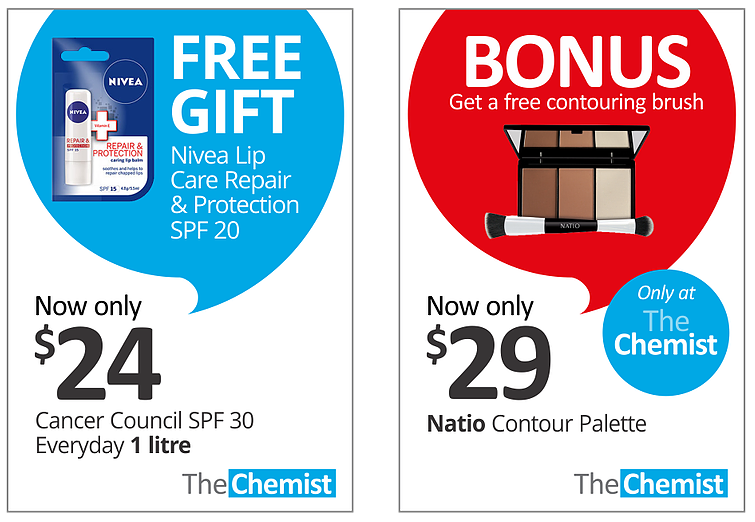
In-store digital signage and advertising
Time-Of-Day specials
Digital signage allows stores to create urgency throughout the day by offering Time-of-Day offers that can create a greater sense of urgency or tailor the offers to the demographics in the store at that time. It works in 2 ways:
Offers that are targeted at the demographics in the store at the time which will be more likely to create a sale.
Not provide offers when they wouldn’t have made a difference. You are giving discounts to incidental sales that you would have made either way.
Promote the Urgency
The dynamic nature of Digital Signage allows stores to display and promote how many products are left in stock, customers are more likely to purchase through fear of missing out, especially when stock levels are low.
While it is not practical to change a printed ticket every time the stock levels change, stores can highlight that the products on display are the last few or there is limited stock.
This is a tactic that can cause immediate sales uplifts when employed alongside high value offers.
Digital Analytics
Digital also allows for a more immediate sense of the effectiveness of a promotion and allows for rapid changes or extensions based on analytics rather than being looked into multi-week promotions that may not be effective or getting the maximum returns.
It allows for constant re-tuning by determining real-time sales attribution by comparing the sales results with advertising activity.
Shoppers assume trust
Consumers trust that an offered discount is a legitimate reduction from the original price. In other words, you could technically raise the price of an item by 20%, then turn around and offer a 20% discount, but consumers very rarely consider this possibility.
Often the shopper will lift shelf talkers to confirm the regular selling price. It is important that you make the regular price clear on your promotional signs so the shopper does not feel compelled to lift the tickets as this can cause damage and lost tickets. A lost or obscured ticket on a promotion is just giving money away.
The cons of discounts
One downside to discounts is that they train consumers to expect them when making a purchase. This expectation often prevents shoppers from purchasing items at regular price.
Consumers learn to expect discounts.
To help prevent customers from only purchasing with a discount, it’s recommended that you be strategic with the type and timing of your discounts. One strategy is to unpredictable with your discounts. If a shopper knows a product is coming back on discount, then they can put of a purchase.
Learning which discounts work for you
Since there are so many ways for you to position discounts with your customers, it’s important to understand which are the most effective in driving sales and increasing basket sizes.
To do this it is recommend testing multiple variations of a discount to see which have the most impact. For example, you can alternate between percentage off and multi-buy discounts that have the same level of savings over several weeks. Based on the results, you’ll have a better understanding of which discounts best appeal to your customers. Keep in mind that discounts are not always one size fits all. It is quite possible that different products and product categories require different discount types. Testing different discount types should be performed across a range of product types.
Once you have a better understanding of how discounts impact your specific customers, you will be in a much better position to mix up your campaigns to boost sales and create a greater shopping experience.
To find out more about Last Yard click here
